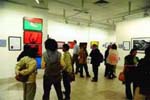 The two-week international festival Chobi Mela VI, organised by Drik, will end today. This year’s arrangement of the biennial festival was perhaps better than the previous ones in terms of higher number of entrees and venues.
The two-week international festival Chobi Mela VI, organised by Drik, will end today. This year’s arrangement of the biennial festival was perhaps better than the previous ones in terms of higher number of entrees and venues.
Beginning on January 21, over 500 entries from 30 countries featuring ‘dream’ were on display at seven venues, which drew attention of a remarkable number of audiences who visited the festival’s seven venues.
This year’s speciality was the live streaming of the all-evening presentations held at Goethe-Institut, Dhaka. The evening presentations included workshops, digital exhibitions and panel discussions. Those who failed to attend the evening presentations could watch the programme on Internet.
Both the local and international photographers who participated in the exhibition appreciated the initiatives of digital exhibitions and workshops as they had the opportunity of swapping thoughts and ideals on photography.
Another interesting point is that the organisers began mobile exhibitions on rickshaw-vans to reach out to different areas of the city. Most of the entrées of the festival were closely related to dreams, aspirations and longings for something beautiful while some of the displays brought visitors face-to-face with the saddening reality of life.
The highest number of photographs, some 290, on diversified subjects was on display at Bangladesh Shilpakala Academy’s National Art Gallery. The venue featured photographs from different countries including Bangladesh, India, Georgia, Australia, Iran, Indonesia, Japan, Mexico, Mozambique and Norway.
One of the most interesting entrées of the venue was American photographer David Burnett’s ’44 Days’ in which he had captured gritty photographs in 1978. A series of photographs portraying the beginning to end of an Iranian uprising was like a story from beginning to end.
The entrées at British Council titled ‘Existence’ by Gareth Philips vividly showcased anguish of terminally ill bed-ridden patients. In contrast, Joanna Petrie’s exhibition titled ‘The Girl Who Fell to Earth’ displayed happiness of a growing child.
The entrée at Dhaka University’s Fine and Arts Faculty of Hungarian photographer Tamas Dezso showcased the increasing urbanisation of the country in ‘Here Anywhere’ while Puerto Rican photographer Karen Knorr’s ‘India Song’ captured the historical palaces of India.
However, there was an allegation that very few local photographers outside the photography school Pathshala got the chance of participating in the international festival.
Denying such allegation, curatorial director of the festival ASM Rezaur Rahman said, ‘We always judge a photograph as a photograph. It doesn’t matter who the photographer is.’ He pointed out that they always welcome more and more local participation–whether from Pathshala or non-Pathshala.
He further said that they had presented visitors with diversified works and had received huge response from the visitors’ side and from both local and international photographers.
The organisers are also gearing up for the next festival scheduled to be held in 2013. Anyone can take part in selection of next year’s theme by casting votes through the organisers’ websites.




















